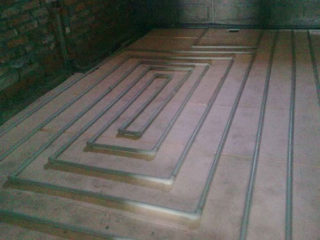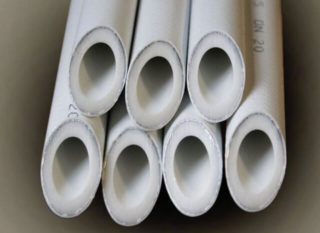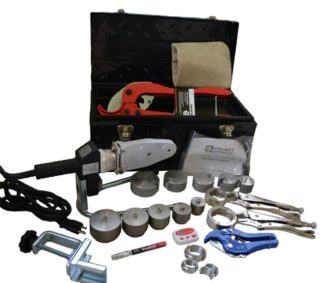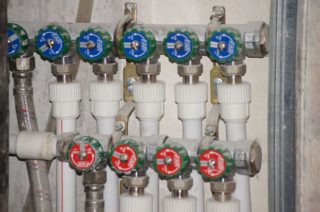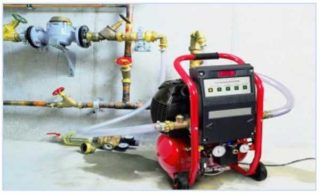Heating options are not limited to mounting radiators on the walls. Underfloor heating systems make staying in a house especially comfortable. They are electric and water. In the first case, heating is carried out by cable, in the second - by pipes with hot coolant. Reliable material for the installation of the system is polypropylene. Plastic pipes withstand high temperatures and last up to 50 years.
Features of warm water floors
The room is heated due to the circulation of the coolant in the circuit, placed in a concrete floor screed. Water is heated in a boiler connected to the system. The movement of fluid in a closed circuit provides a circulation pump. Also, the distribution floor includes a distribution manifold, valves, fittings.
The base of the floor before installation is insulated and waterproofed. After laying, connecting and checking the system, the pipes are poured with a concrete screed. Heat is evenly distributed throughout the entire thickness of the reservoir, accumulated and transferred to the room. This is the best option, heating the house by the principle of convection. In well-insulated rooms, it can serve as the main source of heating.
Warm water floors are usually arranged in private homes. In apartments, systems are not prohibited, but when they are installed, residents face some difficulties.
It is forbidden to connect the water circuit to the central heating system, therefore installation of an autonomous boiler is necessary. In addition, it is necessary to find out whether the floor can support the weight of the concrete screed. One of the main disadvantages of the system is the difficulty of repair in the event of a leak. In an apartment building, the problem will result in flooding of neighbors.
Advantages and disadvantages of polypropylene

One of the most popular types of water heating is a warm floor made of polypropylene pipes. Among the many available materials, he is chosen due to many advantages:
- No corrosion and deposits.
- Chemical inertness, the material does not oxidize when interacting with concrete.
- Reinforced pipes have the strength necessary for safe operation of the system.
- High thermal conductivity of polypropylene provides fast heat transfer.
- Long operation of a heat-insulated floor. With proper installation, the service life is 25-30 years.
- Affordable cost of polypropylene products.
- The material is resistant to temperature fluctuations, does not tear when water freezes.
Disadvantages:
- Polypropylene for underfloor heating does not have flexibility, therefore, when installing the circuit, connecting fittings are required.
- High expansion coefficient when heated.
- To install the system, you need the ability to handle a soldering apparatus.
When choosing the material for mounting the heating system, the thickness and diameter of the pipes are taken into account.
Types of polypropylene pipes
By design, pipes are single-layer and multi-layer. Two large groups are divided into several subgroups according to the type of base material or reinforcement.
Single layer
The scope of the product depends on the material used for their manufacture:
- PPH - homopropylene products for cold water supply.
- PPB is a block copolymer used in low-temperature heating systems.
- PPR - a random copolymer is the best option for installing a warm floor.
- PPS is a non-combustible polypropylene that can withstand high water temperatures.
Another classification parameter is the working pressure. It is indicated by the manufacturer when marking products:
- PN10 is a thin-walled design designed for a pressure of 10 bar and a temperature of 45 ° C.
- PN16 - designed for a nominal pressure of 16 bar.
- PN20 - the product is designed for pipelines with a pressure of 20 bar and water flow up to 75 ° C.
Russian-made pipes have an operating class defined by GOST. For heating, products of 3-4 classes are recommended.
Layered
Pipes consisting of several layers are more resistant to damage and deformation when heated. The reinforcing frame is made of fiberglass or aluminum foil. It is located between two layers of propylene. The foil protects the piping from air entering the closed system. Products with a composite frame are more often used in the installation of a water heated floor. They have the necessary rigidity, do not require stripping when soldering.
Application Nuances
In order for the heating system to work efficiently, it is necessary to perform a preliminary calculation of the number of pipes and choose a laying scheme. It is advisable to carry out a drawing on graph paper. There are two styling schemes - “snake” and “snail”. To speed up the installation, professionals recommend placing the contour on a grid with large cells, attaching it with plastic clips. Laying the pipeline is double and single. The optimum pipe diameter is 16-20 mm.
For the normal functioning of the warm floor, there are several rules for installing polypropylene:
- The total length of the circuit should not exceed 80 meters.
- The recommended pitch of turns is 30 cm, to increase the intensity of heating it is reduced to 15 cm.
- Laying scheme "snake" is simpler, but it is suitable for small rooms.
- The coolant temperature should be between 35-55 ° C.
Before starting work, a floor covering is selected. The underfloor heating system is compatible with tiles, laminate, linoleum.
Step-by-step installation instructions for the polypropylene circuit
The following tools will be required to install a DIY floor heating system from polypropylene pipes:
- soldering iron for plastic with nozzles;
- pipe cutting scissors;
- roulette;
- building level;
- drill.
For the preparation of concrete mortar, it is advisable to use a concrete mixer.
Foundation preparation
The base for the heating system must be horizontal. With significant differences in height, a concrete screed is poured. The design is covered with a layer of waterproofing. The most practical option is a plastic film. A damper tape is glued around the perimeter of the room, compensating for the expansion of concrete. The next step is thermal insulation. To reduce heat loss, plates of foam, foam polystyrene, basalt wool are laid under the circuit. Experts advise using a material with a foil surface. It reflects the warmth of the room.
Installation of polypropylene pipes
Prior to installation, a distribution manifold with valve and valves is mounted. A circuit will join it. Pipes are laid on a heater or reinforcing mesh with 10 × 10 cm cells. The second option is more convenient and reliable. When working with polypropylene, it is important to observe the temperature regime. Installation is carried out in a warm room, where above + 5 ° C.
The contour is laid out according to the intended scheme. Separate sections are connected with a soldering iron. Soldering gives a durable and tight seam. Beginners are advised to perform several test welds so as not to spoil the pipeline. Pipes are attached to the reinforcing mesh with plastic clamps and wire.Fasteners must not be tightened too much.
Hydraulic test
After connecting the circuit to the distribution unit, the system is crimped. Pressure is supplied to the pipeline. The procedure helps to find low-quality seams, cracks. Water is left for a day and the pressure parameters are monitored. If they are stable, the warm floor is assembled efficiently.
Concrete screed pouring
The final stage - pouring cement screed on the lighthouses. The solution is poured onto the floor and stretched as a rule. The optimum layer thickness is 5-7 cm. After the concrete has set, the beacons are removed, the holes are sealed with cement mortar. For uniform drying, the screed is covered with a film and poured with water for 14 days. The inclusion of the underfloor heating system is carried out after 1 month.
Polypropylene pipes are durable, inexpensive and reliable. The material is easy to assemble, allowing you to do the entire amount of work with your own hands.
